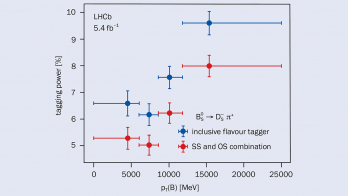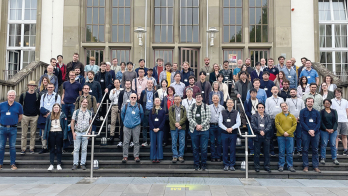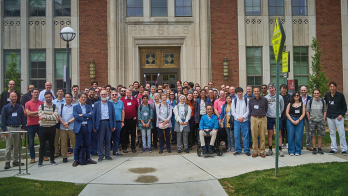A series of workshops examines the future of flavour physics.
Résumé
Comprendre la saveur pour accéder à la nouvelle physique
La physique portant sur les divers types (ou saveurs) de quarks a un fort impact sur la physique des particules et elle pourrait s’avérer cruciale pour accéder à la physique au-delà du modèle standard. L’atelier «Flavour Physics in the LHC Era» a tenu cinq sessions au CERN entre novembre 2005 et mars 2007 pour examiner la manière dont la branche va évoluer à l’avenir. Le but était d’esquisser un programme pour la physique de la saveur dans la prochaine décennie, d’examiner de nouvelles propositions d’expérimentation et de s’intéresser à la relation entre le LHC et les «usines» à saveurs du point de vue du potentiel de découvertes et de l’exploration de la nouvelle physique.
For many years, the interactions between quarks of different flavour and the phenomenon of CP violation – the non-invariance of weak interactions under combined charge-conjugation and parity transformations – have played an important role in particle physics. In 1963, a year before the observation of CP violation in KL → π+π– decays, Nicola Cabibbo introduced the concept of flavour mixing. Ten years later, Makoto Kobayashi and Toshihide Maskawa discovered that quark-flavour mixing allows the accommodation of CP violation in the framework of the Standard Model, provided that there are at least three different replicas – or generations – of the fermion content of this theory. Sheldon Glashow, John Iliopoulos and Luciano Maiani had already introduced the charm quark in 1970 to suppress the flavour-changing neutral currents, and Mary K Gaillard and Benjamin W Lee in 1974 estimated the mass of that quark with the help of the K0–K0 oscillation frequency. Then, in the 1980s, the large value of the top-quark mass was first suggested by the large B0d–B0d mixing seen in the ARGUS and UA1 experiments at DESY and CERN, respectively.
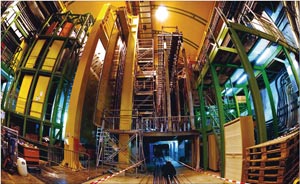
Flavour physics has since continued to progress, and flavour-changing neutral-current processes and CP-violating phenomena are still key targets for research because they may be sensitive to physics lying beyond the Standard Model. Experiments have revealed the particles of all three generations, and have established non-vanishing neutrino masses, leading to a rich flavour phenomenology in the lepton sector, pointing towards new physics. Studies on how the field will continue to progress formed the basis for the five meetings in a series of workshops on Flavour Physics in the LHC Era, which were held at CERN between November 2005 and March 2007.
The rise of the B meson
The kaon system dominated the exploration of the quark-flavour sector for more than 30 years. For the past decade, however, the B-meson system has been the key player. Thanks to the B-factories based on e+e– colliders at SLAC and KEK, with their detectors BaBar and Belle, respectively, CP violation is now also definitely seen in B decays, where the "golden" decay B0d → J/ψKs shows CP-violating effects at the 70% level. These effects can be translated into the angle β of the unitarity triangle, which characterizes the Kobayashi–Maskawa mechanism of CP violation. Several strategies to determine the other angles of the triangle, α and γ, have been proposed and successfully applied to the data from the B-factories. After important first steps in experiments at LEP and at the SLAC Large Detector, the CDF and DØ collaborations at Fermilab’s Tevatron collider last year eventually measured the B0s–B0s oscillation frequency ΔMs. This spring, the B-factories reported evidence for D0–D0 mixing – the last missing meson–anti-meson mixing phenomenon.
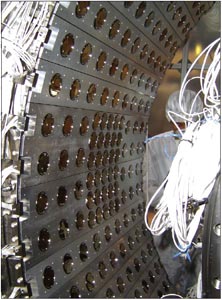
Image credit: MEG collaboration.
So far, these results – together with intensive theoretical work – have shown that the Kobayashi-Maskawa mechanism of CP violation works remarkably well. This complements the precision tests of the gauge sector of the Standard Model and therefore highly constrains any scenario for new physics beyond the Standard Model. On the other hand, neutrino oscillations and the baryon asymmetry of the universe require sources of flavour mixing and CP violation beyond what is present in the Standard Model. This demands the continued exploration of flavour phenomena, improving the current accuracy and probing new observables.
When the LHC at CERN starts up next year, these efforts will be boosted because B-decay studies will be the main theme of the LHCb experiment (CERN Courier July/August 2007 p30). The ATLAS and CMS experiments will mostly focus on the properties of the top quark and on the direct search for new particles, which could themselves be the mediators of new flavour and CP violating interactions. The Bs-meson system is the new territory of the B-physics landscape that can be fully explored at the LHC; this was not accessible at the e+e– B-factories operating at the Υ(4S) resonance. The experimental value of ΔMs is consistent with the Standard Model prediction, although this suffers from lattice QCD uncertainties and still leaves much room for CP-violating new-physics contributions to B0s–B0s mixing, which could be detected at the LHC with the help of the B0s → J/ψφ decay. Bs-physics will also open new ways to determine the angle γ of the unitarity triangle.
These methods make use of pure "tree" decays (e.g. B0s → D±sK+), on the one hand, and of decays with penguin contributions (e.g. B0s → K+K–) on the other. Moreover, the B0s → φφ channel will shed more light on possible new-physics contributions to the CP asymmetries of various b → s penguin modes, which may be indicated by the current B-factory data for B0d → π0KS, B0d → φKS and similar modes. Another key aspect of the LHC B-physics programme will be studies of strongly suppressed rare decays, such as Bs → μ+μ–, which could be highly enhanced through the impact of physics beyond the Standard Model.
Investigations of the extremely rare decays K+ → π+νν and KL → π0νν will complement the studies of Bs-physics. These are very clean from a theoretical point of view, but unfortunately hard to measure. Nevertheless, there is a proposal to take up this challenge and to measure the former channel at CERN’s SPS, and there are efforts to explore the latter – even more difficult decay – at the Japan Proton Accelerator Research Complex (J-PARC).
There are many other fascinating aspects of flavour; the D-meson system is an interesting example. The recently observed D0–D0 mixing can be accommodated in the Standard Model, but suffers from large theoretical uncertainties. New physics may actually be hiding there and could be unambiguously detected through CP-violating effects. Other important flavour probes are offered by the physics of top and by flavour violation in the neutrino and charged-lepton sectors. For the latter, an investigation of the lepton-flavour-violating decay μ → e_ is about to start this year with the MEG experiment at the Paul Scherrer Institute (CERN Courier July/August 2004 p21). In addition, studies of μ → e conversion are proposed at Fermilab and J–PARC. Further studies using τ decays at the LHC and at a possible future super-B-factory will be important in this area. Finally, continued searches for electric dipole moments and measurements of the anomalous magnetic moment of the muon are essential parts of the future experimental programme.
Towards the LHC era
As the start of the LHC rapidly approaches, there is one burning question: what is the synergy between the plentiful information following from analyses of the flavour sector with the high-Q2 programme of the ATLAS and CMS experiments? The extended workshop at CERN focused on this topic and received remarkable interest from the particle-physics community, attracting more than 200 participants from around the world. The workshop followed the standard CERN format with three working groups devoted to the flavour aspects of high-Q2 collider physics; the physics of the B, K and D meson systems; and flavour physics in the lepton sector. This framework allowed many new studies to be performed. The goals of the workshop were to outline and document a programme for flavour physics for the next decade, to discuss new experimental proposals and to address the complementarity and synergy between the LHC and the flavour factories with respect to the potential for discovery and the exploration of new physics. In this context, detailed discussions took place on two proposals for an e+e– super-B-factory, one at KEK and one near Frascati. Such a "super-flavour factory" would allow for precision experiments in quark and lepton flavour physics by accessing the B, the _ and the charm sector. The final meeting complemented this discussion with a review of upgrade plans for LHCb.
The workshop confirmed that flavour physics is an essential element in the further testing of the Standard Model, which should reveal inconsistencies in an unambiguous manner. Should particles associated with new physics be produced at the LHC, studies of flavour physics will play a key role, helping to uncover the underlying new physics, to study the properties of the new-physics particles and to detect or exclude new sources of CP violation and flavour structures.
The detailed results and conclusions of the workshop will be published as a CERN report (in preparation). For further information, see the workshop homepage at http://cern.ch/flavlhc.





